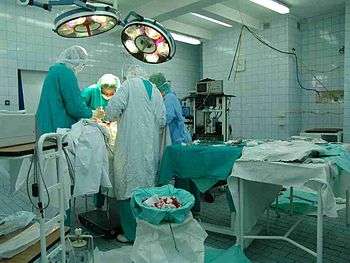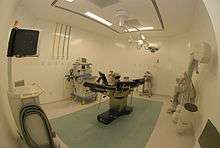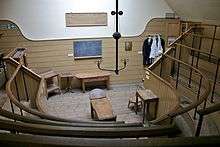Operating theater

An operating theater (also known as an operating room, operating suite, operation theatre, operation room or operation suite) is a facility within a hospital where surgical operations are carried out in a sterile environment. Historically, the term "operating theatre" referred to a non-sterile, tiered theater or amphitheater in which students and other spectators could watch surgeons perform surgery.
Operating rooms
Contemporary operating rooms are devoid of a theater setting (though some in teaching hospitals may have small galleries), making the term "operating theater" a misnomer for the modern facility. Operating rooms are spacious, easy to clean, and well-lit, typically with overhead surgical lights, and may have viewing screens and monitors. Operating rooms are generally windowless and feature controlled temperature and humidity. Special air handlers filter the air and maintain a slightly elevated pressure. Electricity support has backup systems in case of a black-out. Rooms are supplied with wall suction, oxygen, and possibly other anesthetic gases. Key equipment consists of the operating table and the anesthesia cart. In addition, there are tables to set up instruments. There is storage space for common surgical supplies. There are containers for disposables. Outside the operating room is a dedicated scrubbing area that is used by surgeons, anesthetists, ODPs (operating department practitioners), and nurses prior to surgery. An operating room will have a map to enable the terminal cleaner to realign the operating table and equipment to the desired layout during cleaning.
Several operating rooms are part of the operating suite that forms a distinct section within a health-care facility. Besides the operating rooms and their wash rooms, it contains rooms for personnel to change, wash, and rest, preparation and recovery rooms(s), storage and cleaning facilities, offices, dedicated corridors, and possibly other supportive units. In larger facilities, the operating suite is climate- and air-controlled, and separated from other departments so that only authorized personnel have access.
Operating room equipment

- The operating table in the center of the room can be raised, lowered, and tilted in any direction.
- The operating room lights are over the table to provide bright light, without shadows, during surgery.
- The anesthesia machine is at the head of the operating table. This machine has tubes that connect to the patient to assist him or her in breathing during surgery, and built-in monitors that help control the mixture of gases in the breathing circuit.
- The anesthesia cart is next to the anesthesia machine. It contains the medications, equipment, and other supplies that the anesthesiologist may need.
- Sterile instruments to be used during surgery are arranged on a stainless steel table.
- An electronic monitor (which records the heart rate and respiratory rate by adhesive patches that are placed on the patient's chest).
- The pulse oximeter machine attaches to the patient's finger with an elastic band aid. It measures the amount of oxygen contained in the blood.

- Automated blood pressure measuring machine that automatically inflates the blood pressure cuff on patient's arm.
- An electrocautery machine uses high frequency electrical signals to cauterize or seal off blood vessels and may also be used to cut through tissue with a minimal amount of bleeding.
- If surgery requires, a Heart-lung machine, or other specialized equipment, may be brought into the room. Heart lung machine takes the temporary control of the heart and lung during the surgery maintaining the circulation of blood and oxygen content of the body
- Advances in technology now support Hybrid Operating Rooms, which integrate diagnostic imaging systems such as MRI and Cardiac Catheterization into the operating room to assist surgeons in specialized Neurological and Cardiac procedures.
Surgeon and assistants equipment
People in the operating room wear PPE (personal protective equipment) to help prevent germs from infecting the surgical incision. This PPE includes the following:
- a protective cap covering their hair
- masks over their lower face, covering their mouths and noses with minimal gaps to prevent inhalation of plume or airborne microbes
- shades or glasses over their eyes, including specialized colored glasses for use with different lasers. a fiber-optic headlight may be attached for greater visibility
- vinyl gloves on their hands; latex is used as well, but much less common due to latex sensitivity which affects some health care workers and patients
- long gowns, with the bottom of the gown no closer than six inches to the ground.
- protective covers on their shoes
- if x-rays are expected to be used, lead aprons/neck covers are used to prevent overexposure to radiation
The surgeon may also wear special glasses that help him/her to see more clearly. The circulating nurse and anesthesiologist will not wear a gown in the OR because they are not a part of the sterile team. They must keep a distance of 12-16 inches from any sterile object, person, or field.
History

_(8250274128).jpg)
Operating theatres had a raised table or chair of some sort at the center for performing operations, and were surrounded by several rows of seats (operating theatres could be cramped or spacious) so students and other spectators could observe the case in progress. The surgeons wore street clothes with an apron to protect them from blood stains, and they operated bare-handed with unsterilized instruments and supplies (gut and silk sutures were sold as open strands with reusable, hand-threaded needles; packing gauze was made of sweepings from the floors of cotton mills). In contrast to today's concept of surgery as a profession that emphasizes cleanliness and conscientiousness, at the beginning of the 20th century the mark of a busy and successful surgeon was the profusion of blood and fluids on his clothes.
In 1884 German surgeon Gustav Neuber implemented a comprehensive set of restrictions to ensure sterilization and aseptic operating conditions through the use of gowns, caps, and shoe covers, all of which were cleansed in his newly invented autoclave.[1] In 1885 he designed and built a private hospital in the woods where the walls, floors and hands, arms and faces of staff were washed with mercuric chloride, instruments were made with flat surfaces and the shelving was easy-to-clean glass. Neuber also introduced separate operating theaters for infected and uninfected patients and the use of heated and filtered air in the theater to eliminate germs.[2] In 1890 surgical gloves were introduced to the practice of medicine by William Halsted.[3] Aseptic surgery was pioneered in the United States by Charles McBurney.[4]
Surviving operating theaters

While operating theaters are no longer used for surgery, some still exist. One of the oldest surviving operating theaters is the Old Operating Theatre in London. Built in 1822, it is now a museum of surgical history. Another theater still exists at the University of Padua, in Italy, inside Palazzo Bo. It was commissioned by the anatomist Girolamo Fabrizio d'Acquapendente in 1594. Another famous operating theater is the Ether Dome in Boston. Built in 1824, it is now a conference room and tourist attraction. Pennsylvania Hospital in Philadelphia also boasts its own surviving operating theater, built in 1804.[5]
Popular culture
- In the "Homer's Triple Bypass" episode of The Simpsons, Homer Simpson has an operation performed on him in an operating theater.
- In Lemony Snicket's The Hostile Hospital, Count Olaf disguises his henchmen as doctors and tries to perform a "cranioectomy" (decapitation) on Violet Baudelaire for a live audience in an operating theater.
- In the Seinfeld episode The Junior Mint, Kramer accidentally drops a Junior Mint into the body of the patient Roy, Elaine's boyfriend, who is having a splenectomy. Miraculously, his condition improves and the doctor declares that, during the operation, something "staved off [the] infection; something beyond science...something, perhaps, from above."
- During a stand-up routine in "The Ex-Girlfriend", Jerry prefers operations in small rooms as opposed to operating theaters: "You don't want the doctors doing anything that'll make the other doctors go 'I have to see this!'"
- Many scenes of the Cinemax series The Knick, set in the fictional Knickerbocker Hospital in New York City in 1900 and 1901, are set in the hospital's operating theatre, which has tiered seating surrounding the operating table from which other surgeons, students, or just interested spectators can watch the surgical procedures.
- In the Grey's Anatomy episode "This Magic Moment," Dr. Meredith Grey refers to the OR as an operating theatre during the opening narration of the episode.
See also
References
- ↑ Deysine, M (2003). Hernia infections: pathophysiology, diagnosis, treatment, prevention. Informa Health Care. pp. 13. ISBN 0-8247-4612-0.
- ↑ Bishop, WJ (1995). The Early history of surgery. Barnes & Noble. pp. 169. ISBN 1-56619-798-8.
- ↑ Porter, R (2001). The Cambridge illustrated history of medicine. Cambridge University Press. pp. 376. ISBN 0-521-00252-4.
- ↑ Gross, E (1990). This day in American history. Verlag für die Deutsche Wirtschaft. pp. 61. ISBN 1-55570-046-2.
- ↑ http://www.uphs.upenn.edu/paharc/tour/tour5.html